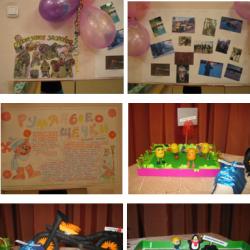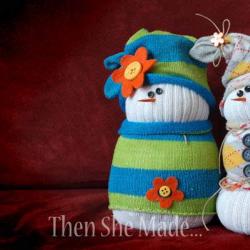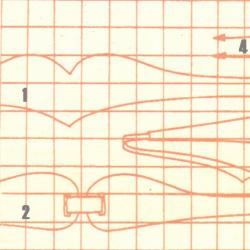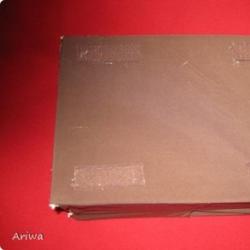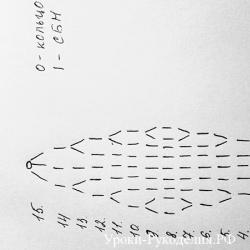Knitting from sectional yarn. Jumper for a baby made of sectional knitted yarn. What to knit from section-dyed yarn
The variety of yarn allows craftswomen to experiment and create unique things. Modern ones have many names that differ in composition, color and properties.
Section-dyed yarn can be classified as fancy due to its interesting and sometimes unexpected color schemes. The good thing about this yarn is that you don’t need to select and combine colors for the product yourself.
Single-color sections can be short or long, allowing for control over the knitting. Yarn (sectional yarn) with short sections produces a bright, slightly variegated fabric. This thread is ideal for knitting children's clothes or accessories - scarves and hats. Large sections fit into the product in wide, well-combined stripes.
Knitting from sectionally dyed yarn can be done either by crochet or knitting. Depending on the chosen tool and working technique, a fabric knitted with the same thread may look different.
Manufacturers of section-dyed yarn
Knitting with yarn (sectional yarn) always begins with choosing the ideal yarn composition and color combinations. Fortunately, there are many options - almost all major yarn manufacturers produce a sectional line. The most famous of them:
- Alize Burcum Batik. 100% acrylic (100 g/210 m). The thread is ideal for children's knitting and for those with sensitive skin prone to allergic reactions. The yarn is very soft, pleasant to the touch, does not squeak or curl during operation. Pleases with noble color combinations.
- Alize Angora Gold Batik. 10% angora, 10% wool, 80% acrylic (100 g/550 m). Thin, delicate fluffy thread of sectional dyeing. It makes light, airy stoles, shawls, and dresses.
- Vita Cotton Coco print. 100% gas-colored mercerized cotton (50 g/240 m). This cotton thread makes wonderful summer items. It looks best in lace and openwork patterns. The color combinations seem to be specially created for bright things for spring and summer.
- Magic. 100% wool (100 g/200 m). Winter knitting is incomplete without this thread. The yarn (sectional yarn) of this brand makes very warm and beautiful things. It is suitable for creating bright, stylish cardigans and sweaters, hats and scarves, socks and mittens.
- "Kamtex". "Chrysanthemum Print". 40% mohair, 60% acrylic (100 g/350 m). Yarn from a domestic manufacturer is ideal for knitting openwork shawls and stoles with a smooth transition of colors.

What to knit from section-dyed yarn
Handicraft magazines and thematic websites offer many patterns that can be used to knit from sectional yarn. Models vary in complexity and styles, but even the simple execution of some models due to complex thread dyeing makes things original and stylish.
The “sectional section” produces not only beautiful large items, such as dresses and jumpers, but also small accessories, for example, sets of hats and snoods, knitted knee socks and socks. For small products, yarn with short sections is more suitable, for large ones - with long sections.
Knitting bactus

It is better to start knitting from yarn (sectional yarn) with a simple product, for example, the now very fashionable bactus. On it, the colored sections will reveal themselves in the most advantageous way due to its triangular shape.
Bactus can be knitted with knitting needles or you can get an original product in the style of Bosnian knitting. The scarf begins to be knitted from one edge, gradually widening and then shortening the rows where the bactus narrows.
You can start working with knitting needles from the center, gradually expanding each “wing” of the bactus. The finished product can be decorated with tassels or fringe.
Prepare circular knitting needles and sectional dyed yarn. We will knit such a wonderful top.
Size: 36-38/ 40-42/ 44-46.
You will need: 350/ 400/ 450 g yarn SMC Cotton Bamboo Batik, color number 00083
2 pairs of circular needles No. 3-4
Patterns and types of loops
Pattern: faces. R. and out. R. elm. according to the scheme. In purl. R. elm. double sts and yarn overs. reception, the remaining p. elm. according to the drawing.
Yarn over extends the rapport by 1 st in the 2nd row, then by 2 sts in every 2nd row. Elm 1-5th r.. repeat. 3 times 6-13th r. and 4 times 14-21 r. = 61r., repeat. 22-25th r. to end.
Chrome. p.: at the beginning R. n. 1st p. persons. reception, thread at work, at the end of the river. elm. last p. persons. reception.
Sn. p.: 1 persons. n. in persons r., in purl. R. n. 1 p. purl. reception, thread before work.
Ub. 1 p. at the beginning piz. r.: elm. chrome p.. sn. n. persons reception. 1 person p.. stretch sn. p. through knitted.
Ub. 2 p. at the beginning persons r.: elm. chrome p.. sn. n. persons reception, 2 persons. p. vm., stretch sn. p. through knitted. 1 or 2 p. at the beginning. purl r.: elm. chrome p.. sn. n. out. reception, thread before work. elm. persons or purl. We use 2 or 3 stitches.
Knitting density 10 x 10 cm = 16 p. x 32 r. pattern.
Note. Knit, starting from the bottom edge of the neckline (the direction of knitting is indicated by arrows on the pattern drawing). Knit each piece in the sequence indicated by the numbers on the pattern drawing. Part 1: beginning elm. from inside r., parts 2-6 -beginning. elm. from persons R. To complete parts 2. 3 and 5, remove the corresponding part onto the 2nd circular needle, leaving the remaining stitches on the 1st circular needle.
Completing of the work
Back: beginning elm. from part 1. Cast on 7 sts and in the 1st purl. R. elm. chrome p.. 5 p. p.. chrome. n. Cont. perform the pattern next.
way: chrome. p.. 4 times repeat. rapport, 1 double stitch, chrome. p. At a height of 17 (18.5; 20) cm (= 55 (59; 63) p.) from the cast-on p = 219 (235; 251) p. on the knitting needle - part 1, elm. detail 2 next way: chrome. etc. and next 54 (58;62) p. Simultaneously perform dec. to form a shoulder bevel trace. way: in the beginning track. persons R. ub. 1 (2;1) p., as shown, then dec. in every 2nd r. *3 times for I p, and 1 time for 2 p*., repeat. 5 times from * to * (dec in every 2nd p. 2 p. then * 3 times 1 p. and 1 time 2 p. *, repeat 5 times from * to *; dec in every 2- m p. * 2 p. and 2 times 1 p. *, repeat 7 times from * to *, then 2 more times 2 p.). At the same time at the beginning 1st purl. r., or in the 56th (60th; 64th) r. to make an armhole ub. 1 p., then in every 2nd p. 23 (24; 25) times 1 p. Close off the last 2 p. Elm. second shoulder bevel = part 3 symmetrically at 55 (59; 63) p. Dec. for the shoulder bevel at the beginning. purl r.. perform the armhole at the beginning. persons R. Elm. remaining 109 (117:125) stitches on the bottom edge of the back. Further beginning elm. from detail 4. At the same time elm. double p. at the beginning R. and sn. p. at the end of the river, approx. 1 chrome each n. on both sides. =111 (119; 127) p. In the beginning. each person. R. and out. R. ub. 1 p. and elm. 1 yarn over on both sides from the central point. At a height of 12.5 (10; 7.5) cm (= 40 (32; 24) r.) from the beginning. details 4 elm. first 55 (59; 63) p. in the beginning. R. for part 5 trace, in this way: from the right edge dec. 1 p. at the beginning each person. R. At the same time elm. persons taking chrome p. at the end of the river bottom edge of the top vm. from previous p.. until 3 p. remain. Elm. these 3 p. persons. reception of vm. next persons R. Cut the thread and pull through the remaining sts. For part 6 of the lower edge of the back, close the 1st st = central st of the back at the beginning. 1st person r., then elm. for part 6 symmetrically 55 (59; 63) p. trace, like this: in the beginning. persons R. ub. 1 p., as shown, at the end of knit. R. elm. persons reception sn. p.vm. from previous n. The total height at the center of the back is 65 cm.
Dimensions: 62-68 (74-80/86-92) 98-104
You will need: yarn (100% cotton; 125 m/50 g) - 150 (150/200) 250 g white-green-blue sectional dyeing; knitting needles No. 3.5 and 4; long circular knitting needles No. 3.5; 3 small buttons with a diameter of 1 cm.
Elastic band (knitting needles No. 3.5): alternately knit 2, purl 2.
Main pattern (knit stitch, knitting needles № 4): front rows - front loops, purl rows - purl loops.
Garter stitch: knit front and back rows.
Knitting density: front stitch – 22 p. x 28 r. = 10 x 10 cm.
Important: knit the model with two balls for better distribution of colors. To do this, alternately knit 2 rows from each ball.
Back: On knitting needles No. 3.5, cast on 60 (68/76) 86 loops and knit 2 cm with an elastic band. Then switch to needles No. 4 and knit with the main pattern. After 15 (18/21) 23 cm from the initial row, close on both sides for the armholes, 3 stitches and in every 2nd row. close on both sides another 3 x 2 p. = 42 (50/58) 68 p. After 25 (30/35) 39 cm from the initial row, close the right 30 (36/42) 50 p., and on the remaining 12 (14 /16) 18 sts, knit another 1.5 cm for the placket. Then close all the loops.
Before: knit like a back, but with a neckline. To do this, after 22 (26/31) 35 cm from the initial row, close the middle 12 (12/14) 16 stitches and finish both sides separately. First, continue knitting 15 (19/22) 26 sts along the left edge = end of the row. To round the neckline at the beginning of each front row, bind off 1 (2/2) 4 x 2 p. and 1 (1/2) 0 x 1 p. After 25 (30/35) 39 cm from the initial row, bind off the remaining 12 (14/ 16) 18 shoulder stitches. Then continue knitting for 15 (19/22) 26 sts along the right edge = beginning of the row. To round the neckline, close at the beginning of each purl row 1 (2/2) 4 x 2 p. and 1 (1/2) 0 x 1 p. At the same time after 23.5 (28.5/33.5) 37.5 cm from the initial row continue to knit for the placket in garter stitch and in the 1st r. make 2 holes for buttons as follows: 2 (3/4) 5 p., 1 yarn over, knit 2 p. together, 4 p., 1 yarn over, knit 2 p. together, knit the remaining loops. In the purl row, knit yarn overs. After 25 (30/35) 39 cm from the starting row, bind off the remaining 12 (14/16) 18 shoulder stitches.
Sleeves: On knitting needles No. 3.5, cast on 38 (42/46) 46 loops for each sleeve and knit 2 cm with an elastic band. Then switch to needles No. 4 and knit with the main pattern. For side bevels, add sleeves every 8th r. (alternately in every 6th and 8th r. / in every 6th r.) alternately add in every 4th and 6th r. from the elastic on both sides 4 (6/9) 13 x 1 p. = 46 (54/64) 72 p. After 16 (19/22) 26 cm from the initial row, close on both sides to roll up the sleeves 3 p. and in every 2nd r. bind off another 3 x 2 sts. After 18 (21/24) 28 cm from the initial row, bind off the remaining 28 (36/46) 54 sts.
Assembly: Stretch the parts, moisten them and let them dry. Place the left shoulder strap under the front strap and pin. Use a mattress stitch to sew the right shoulder seam. Sew in the sleeves. Use a mattress stitch to sew the side seams and sleeve seams. For the neck strap, using knitting needles No. 3.5, evenly cast on 64 (68/72) 76 sts along the edge of the neck and knit 1.5 cm with an elastic band, while at the beginning of the 1st r. make the 3rd hole for the button as follows: 2 p., knit 2 p. together, 1 yarn over, knit the remaining loops of the row. In the next row, knit the yarn over according to the pattern. Then close all the loops according to the drawing. Sew buttons.
You can often find that any yarn that is not smoothly dyed is called melange. But not all variegated yarn is melange. One of these variegated threads is section-dyed yarn. In this article I want to pay special attention to section-dyed yarn, consider its properties and the features of knitting from such yarn.
Knitting from sectionally dyed yarn allows you to make both a variegated and striped fabric, which cannot be said about knitting with melange thread. Knitting from melange yarn allows you to make only a variegated fabric.
To obtain section-dyed yarn, the yarn is dyed after spinning. The color palette, as well as the length of the color segment, may vary. But there is a certain rule: even if the length of the color section is different, the color sequence must always be repeated.

Section-dyed yarn allows needlewomen to create a huge variety of patterns without using many multi-colored balls. But it should be noted that knitting from such yarn is very difficult, because when you start knitting from section-dyed yarn, you often cannot predict what kind of pattern you will get in the end. Even knitting a sample will not always help you with this.
According to the length of the color segment, section-dyed yarn is divided into:
- Finely sectioned yarn;
- Mid-section yarn;
- Long section yarn.
The short length of the color segments allows you to create a variety of geometric shapes when knitting. This yarn behaves unpredictably. It is difficult to replicate a model from a magazine and often results in sloppy stains in the wrong place. The color scheme in symmetrical parts turns out to be asymmetrical; the side seam is clearly visible in the product. When changing the number of loops, the pattern becomes distorted. Randomly scattered spots of color sometimes spoil the silhouette of the product.

Long sections of color segments when knitting make it possible to obtain stripes. This yarn behaves quite predictably.

It should be noted that knitting from the same ball gives a different result in the pattern when crocheting or knitting.
What to look for when buying section-dyed yarn
Firstly, of course, you need to pay attention to the length of the color segment, because the color pattern of the future product largely depends on this. The shorter the color segment, the more colorful the product will be. With long color segments, the product will turn out striped.
When choosing yarn, be sure to consider what you plan to knit with it. Fine-section and medium-section yarn are suitable for small items such as scarves, hats or children's items. Mid-section and long-section yarn will be good for jackets and sweaters, various capes, as well as stoles and shawls.

Secondly, pay attention to the relationships between the color segments in the skein. Different colors in a skein may have different lengths. If preference is given to one color in the ball - it has a longer segment or is repeated more often, then in the product this color will set the tone of the entire product.
Third, it is advisable to purchase section-dyed yarn in large skeins, and also pay attention to the direction of the color change sequence when winding in skeins. All this will allow you to make the transition from skein to skein unnoticeable.

Rules for knitting from section-dyed yarn
You can knit from section-dyed yarn like you would from regular plain-dyed yarn, without thinking about what pattern you will get in the end. In this case, the pattern can be chaotic, giving the product originality and uniqueness.
But if you want to get a certain pattern, then when knitting you should pay attention to some rules when working and follow them:
- All balls must be wound in the same color sequence.
- To eliminate the possibility of pattern distortion in symmetrical pieces, start knitting them from the same color section.
- In order to obtain the intended color spots in the product, carefully study the length and sequence of alternating color segments.
- In order to choose a design that is more suitable for the product, knit several samples, starting each with a different color segment. This will help you reduce the risk of ending up with a mismatched pattern ensemble.
- After you have selected the optimal pattern, you need to adjust the pattern of the product to the pattern repeat. Often the sectional yarn determines the model of the product. Therefore, do not take a product with a very complex cut and with predetermined color effects. The simplest parts are the rectangular parts of the back, shelves and sleeves.
- If the calculated width of the parts turns out to be not a multiple of the number of repeats, then slightly narrow or, conversely, widen the part. Try playing with the transfer of the side seam to adjust the rapport: slightly narrow the back and widen the front. At the same time, do not forget to adjust the armhole too.
- Often it is the first row that causes a certain difficulty, since it is difficult to adjust the desired turn in the right place. Therefore, it is better to cast on more loops (about 15 - 20 more loops) than needed, and subsequently remove the extra tail.
- Keep an eye on the color section of each new ball. Start knitting from a new ball with the same color each time, even if it is necessary to remove a whole color repeat.
- If the thread has a defect in the form of a knot, break, elongation or, conversely, shortening the length of the dyeing segment, then it is better to remove the defective repeat and start with the next one.
- Minor disruptions in the pattern (approximately 1 – 3 loops) can be compensated by knitting density: knit the loops tighter or looser. Due to the variegation of the canvas, this will not be noticeable.
- When changing the number of loops when knitting darts, armholes, and necklines, certain difficulties arise. For beginner knitters, it is advisable to take a model with rectangular armholes and necklines. The reduction of the armhole and neckline is made in multiples of the rapport. This allows you to save the pattern. If the neckline turns out to be too wide, then it can be adjusted with various types of trims, for example, by making additional binding, adding lace, adding a placket, etc.
- It is better to knit the sleeves rectangular with a width that is a multiple of the pattern repeat.

Openwork sweater knitted from section-dyed yarn
Section-dyed yarn was used to create an openwork sweater with knitting needles in interesting patterns
Openwork sweater knitted with zigzag holes in the pattern
Size: European, 38.
Materials: 4 skeins of Fio Cisne Cake yarn (100% acrylic, 100 g/250 m), needles No. 4.
Knitting density: 20 loops * 28 rows = 10 * 10 cm.
How to knit 2 together knit to the right: We insert the right knitting needle first into the second, then into the first loop and knit two loops together with the front one behind the front wall.
How to knit 2 together knit to the left: remove the loop, knit 1, then throw the removed loop over the knitted one.
Double decrease: remove the loop, knit the next two loops together with the knit stitch to the right, throw the removed loop over the knitted one.
Openwork knitted sweater, job description:
Back: cast on 81 stitches.
Knit exactly 16 rows.
Before: cast on 81 stitches.
Knit 1 knit/1 purl with an elastic band – 6 cm.
Next knit: 8 loops in garter stitch, 65 loops in the pattern according to the pattern, 8 loops in garter stitch.
At a height of 12 cm, begin to decrease one loop on each side in every 14th row - 4 times.
Knit exactly 16 rows.
Start adding one loop on each side in every 14th row - 3 times.
At a height of 42 cm, close the armholes on each side in every second row 1 time 5 loops and 2 times 1 loop.
At a height of 10 cm from the armholes, close the central 15 loops for the front neckline.
Knit the sides of the front separately, continue to close from the side of the neck in every second row 1 time 3 loops, 1 time 2 loops and 4 times 1 loop.
At a height of 20 cm from the armholes we bury all the loops.
Sleeve: cast on 81 stitches.
Knit 1 knit/1 purl with an elastic band – 8 cm.
Next knit: 1 loop in garter stitch, 39 loops in the pattern according to the diagram, 1 loop in garter stitch.
Add one loop on each side in every 10th row - 12 times.
Knit new stitches in a garter pattern.
At a height of 48 cm, close on each side in every second row 1 time 5 loops and 11 times 1 loop; in every third row 6 times 1 loop; again in every second row 1 time 2 loops and 1 time 3 loops.
Close all loops.
Assembly: sew all the details.


